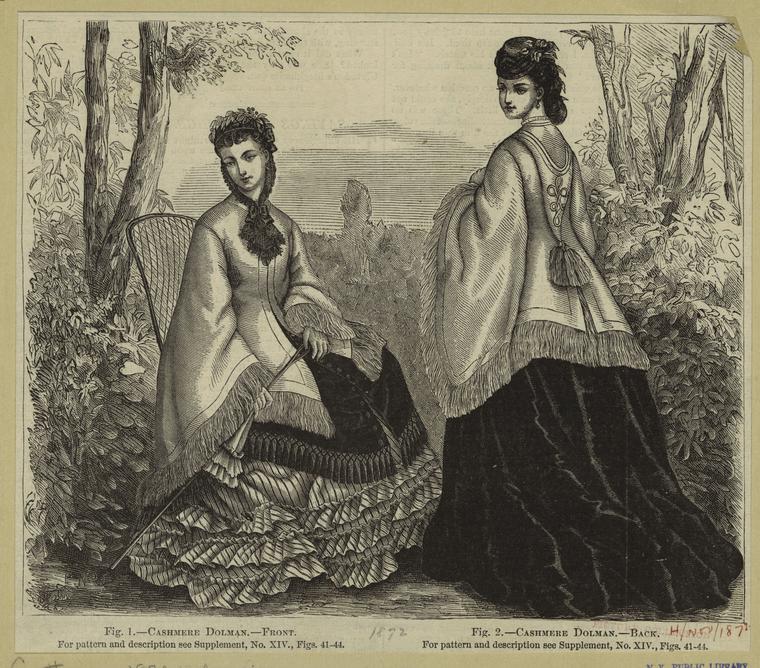|
1840s In Western Fashion
1840s fashion in European and European-influenced clothing is characterized by a narrow, natural shoulder line following the exaggerated puffed sleeves of the later 1820s and 1830s. The narrower shoulder was accompanied by a lower waistline for both men and women. Women's fashion Gowns Shoulders were narrow and sloping, waists became low and pointed, and sleeve detail migrated from the elbow to the wrists. Where pleated fabric panels had wrapped the bust and shoulders in the previous decade, they now formed a triangle from the shoulder to the waist of day dresses. Skirts evolved from a conical shape to a bell shape, aided by a new method of attaching the skirts to the bodice using organ or cartridge pleats which cause the skirt to spring out from the waist. Full skirts were achieved mainly through layers of petticoats. The increasing weight and inconvenience of the layers of starched petticoats would lead to the development of the crinoline of the second half of the 1850s. S ... [...More Info...] [...Related Items...] OR: [Wikipedia] [Google] [Baidu] |
1830s In Western Fashion
1830s fashion in Western and Western-influenced fashion is characterized by an emphasis on ''breadth'', initially at the shoulder and later in the hips, in contrast to the narrower silhouettes that had predominated between 1800 and 1820. Women's costume featured larger sleeves than were worn in any period before or since, which were accompanied by elaborate hairstyles and large hats. The final months of the 1830s saw the proliferation of a revolutionary new technology—photography. Hence, the infant industry of photographic portraiture preserved for history a few rare, but invaluable, first images of human beings—and therefore also preserved our earliest, live peek into "fashion in action"—and its impact on everyday life and society as a whole. General trends The prevalent trend of Romanticism from the 1820s through the mid-1840s, with its emphasis on strong emotion as a source of aesthetic experience and its recognition of the picturesque, was reflected in fashion as in o ... [...More Info...] [...Related Items...] OR: [Wikipedia] [Google] [Baidu] |
Riding Habit
A riding habit is women's clothing for horseback riding. Since the mid-17th century, a formal habit for riding sidesaddle usually consisted of: * A tailored jacket with a long skirt (sometimes called a petticoat) to match * A tailored shirt or chemisette * A hat, often in the most formal men's style of the day (since the Victorian era, a top hat with a veil has been worn) Low-heeled boots, gloves, and often a necktie or stock complete the ensemble. Typically, throughout the period the riding habit used details from male dress, whether large turned cuffs, gold trims or buttons. The colours were very often darker and more masculine than those on normal clothes. Earlier styles can be similar to the dresses worn by boys before breeching in these respects. When high waists were the fashion, from roughly 1790 to 1820, the habit could be a coat dress called a ''riding coat'' (borrowed in French as redingote) or a petticoat with a short jacket (often longer in back than in fron ... [...More Info...] [...Related Items...] OR: [Wikipedia] [Google] [Baidu] |
Juliann Jane Tillman
Juliann Jane Tillman was an American preacher in the African Methodist Episcopal Church. She is known for her lithograph portrait printed in 1844 in Philadelphia, which is held in the Library of Congress, and is often referenced by historians discussing 19th-century women preachers. Portrait The portrait is labeled "Mrs. Juliann Jane Tillman, Preacher of the A.M.E. Church", and was engraved by Alfred Hoffy and printed by Peter S. Duval in Philadelphia. In the portrait, Tillman looks directly at the viewer and gestures, exhorting the viewer "to prepare for the second coming of Christ as in the Book of Revelation." The print itself was reproduced many times to help the AME Church reach a wider congregation, and is indicative of Tillman's popularity. Personal life Very little is known about Tillman herself. Tillman was quoted in an 1837 religious newspaper that she had overcome her own doubts – as well as the opposition of clergymen and laymen – after repeated visits by an ... [...More Info...] [...Related Items...] OR: [Wikipedia] [Google] [Baidu] |
Mantle (clothing)
__NOTOC__ A mantle (from old French ''mantel'', from ''mantellum'', the Latin term for a cloak) is a type of loose garment usually worn over indoor clothing to serve the same purpose as an overcoat. Technically, the term describes a long, loose cape-like cloak worn from the 12th to the 16th century by both sexes, although by the 19th century, it was used to describe any loose-fitting, shaped outer garment similar to a cape. For example, the dolman, a 19th-century cape-like woman's garment with partial sleeves is often described as a mantle. In English, the idiom "to take up/pick up/assume the mantle" is from the Bible, and means to take a position of authority, leadership or responsibility in a particular area, especially in the sense of carrying on for a previous figure. The most notable appearance in the Bible is in 2 Kings 2:13, where Elisha takes up Elijah's mantle ( ''’addereṯ''). Mantelets A variation on the mantle is the mantelet (also spelled mantelot and mantlet ... [...More Info...] [...Related Items...] OR: [Wikipedia] [Google] [Baidu] |

_1836_-_1840.jpg)


